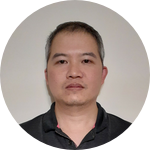About This Project
Ultrafine bubbles have been proven to have many positive effects on living organisms. They boost the vegetable growth rate by increasing oxygen exchange in the root zone to accelerate nutrient uptake.
Our project aims to answer two main questions:
How much ultrafine (micrometers/nanometers in diameter) bubbles can help to increase crop yield in hydroponics farming?
Which ultrafine-bubble sizes are optimum for increasing plant growth rate?
Ask the Scientists
Join The DiscussionWhat is the context of this research?
Ultrafine (Micro-/Nano-) bubbles are gas bubbles that have a diameter smaller than 50 micrometers that can be induced in liquid (usually water) using a generator. Due to their small sizes, ultrafine bubbles can remain suspended in liquid for a long time, in contrast to normal (macro-) bubbles that will rise to the surface and burst (off-gassing) without enriching the liquid with gas particles.
Many scientific studies have been done to research their potential applications: wastewater treatment, boosting growth rate in plants and animals.
In hydroponics settings, circulating ultrafine bubbled water through the system will create constant contact between plants' roots and bubbles, increasing gas exchanges and nutrient uptakes, resulting in a potential increase in crop yield.
What is the significance of this project?
Quantifying the effects of ultrafine bubbles on crop yield increase compared with the cost of ultrafine bubble induction will help optimize hydroponics settings for the most efficient vegetable production, make hydroponics farming more profitable. This project will contribute to accelerating the transition from traditional farming systems to a more energy- and nutrient-efficient system with less nutrient pollutions and land requirements.
What are the goals of the project?
This project aims to answer 2 main questions: 1) How much ultrafine bubbles help increasing growth rate of plants in hydroponics settings? 2) Which bubble sizes are the best?
We will use 10 individual hydroponics setups: #1 (control group): traditional hydroponics settings with only pump for water circulation through plants' roots. #2 to #10: bubbles of different controlled diameters will be introduced into each setup: 200nm, to 800nm, and 1um to 50um. Each hydroponics setup will contain 36 planting pots with 4 different types of plants (9 each): Lettuce, Spinach, Basil, Cherry Tomato. At the end of the harvesting cycle for each type of plants, we will measure: height and weight of each group of plants and compare between setups.
Budget
Hydroponics setups and LED lights: different setups are needed to study the effects of using ultrafine bubbles compared to traditional hydroponics farming settings. Average bubble sizes will be also tested in a separate setup and compare side by side the growth rate of plants (vegetables) to find the optimum bubble diameters for increasing crop yield.
3D printer: we will be able to duplicate our in house designed ultrafine-bubble generator (with controllable bubble sizes) using a reliable 3D printer. Each hydroponics setup will need at least one ultrafine-bubble generator.
High pressure water pumps: are the main component to generate ultrafine-bubbles and circulating water through plants' roots in hydroponics setup.
Scanning Electron Microscope service: to determine bubble size for each hydroponics setup.
Air compressor: for certain size of bubbles, a pressurized gas source might be needed to induce air into the bubble generator.
Endorsed by
 Project Timeline
Project Timeline
We aim to finish the project by the end of 2022 once all necessary data is collected to prove the effectiveness of the project.
Duplicating ultrafine bubble generators and measuring bubble sizes will be done by May 14th, 2022.
The second period from May 15th to December 15th, 2022 will be dedicated to testing the real effectiveness of ultrafine bubbles in gaining crop yield of hydroponics farming.
Jan 15, 2022
Project Launched
Feb 01, 2022
Project launch
Feb 02, 2022
Purchasing 3D printing resources
Feb 15, 2022
Starting small scale production of ultrafine bubble generators using 3D printer
May 01, 2022
Ordering Scanning Electron Microscope to measure bubble sizes and densities.
Meet the Team
Team Bio
Aquatic circle LLC is founded by Dr. Dung Minh Hoang in 2021 with the aim of developing innovative and nature-based solutions for nutrient recycling, water processing, and waste treatments. Working with nutrient management experts and plant physiologists at University of Maryland Center for Environmental Science (UMCES), the company is developing organic and innovative solutions for a more sustainable and cleaner farming system.
Dung Minh Hoang
CEO/Founder of Aquatic Circle LLC
Former research scientist in Biomedical Engineering at the Department of Radiology as part of the NYU Langone Health.
Experiences:
- Design and development of instrumentation and hardware setup to monitor and study experimental models of human diseases
- Develop innovative Imaging procedures and strategies leading to peer-reviewed scientific publications
- Design and development of various MRI probes for small animal imaging
- Computer Science and Programing of various language including C++, Matlab, G-code, Autodesk Computer Aided Design and Computer Aided Manufacturing (CAD/CAM)
- Novel machining technologies: computerized numerical control milling and 3D printing including Fused Deposition Modeling (FDM), Stereolithography (SLA), Multi Jet Fusion (MJF), Direct Metal Laser Sintering (DMLS), Electron Beam Melting (EBM) etc...
Lab Notes
Nothing posted yet.
Project Backers
- 7Backers
- 2%Funded
- $166Total Donations
- $23.71Average Donation

